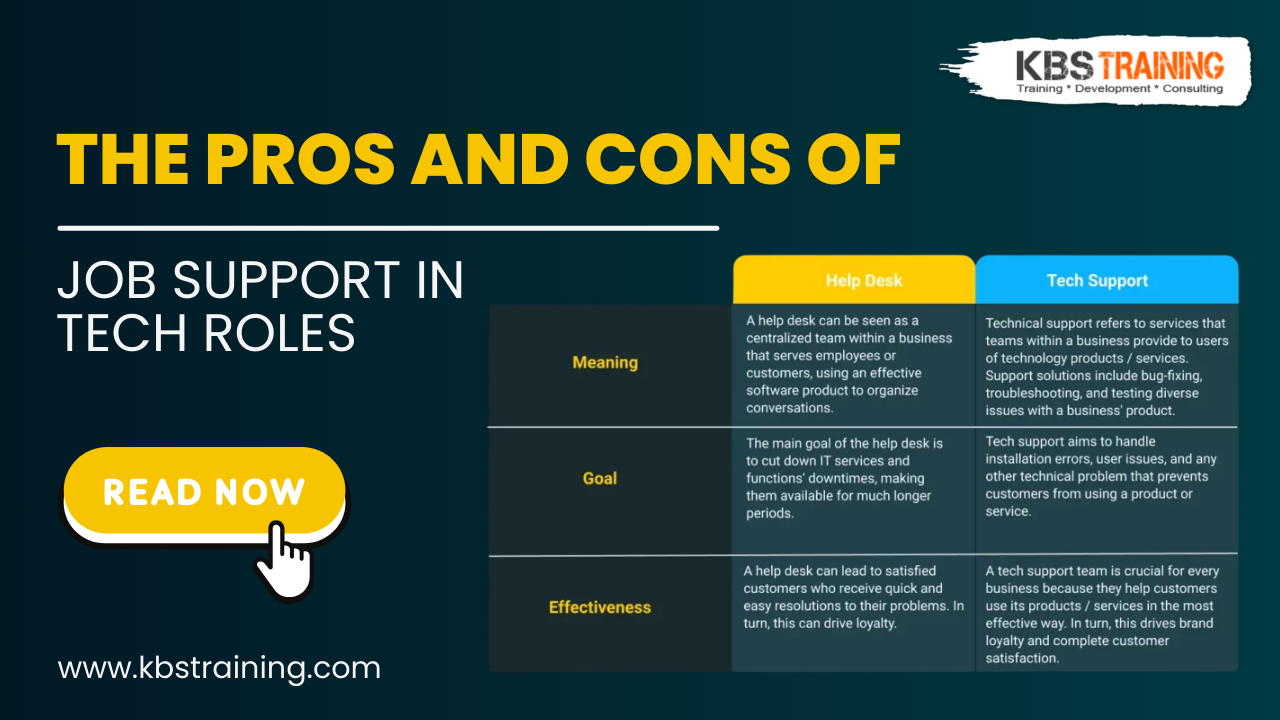In technical fields like software development, IT infrastructure, cybersecurity, and DevOps, job support has become a major tool for success. As of 2025, systems are more complex than ever—AI-driven infrastructure, hybrid clouds, and edge computing are now the norm.
With this shift, professionals increasingly depend on job support for technical roles to resolve challenges quickly, stay updated with evolving tools, and remain competitive. But while job support boosts efficiency and learning, it’s not without drawbacks.
So, is this support system a career booster—or a crutch? Let’s weigh the pros and cons.
✅ Pros of Relying on Job Support
1. 🚀 Faster Problem Resolution
In high-pressure roles, time is money. Whether it’s a server outage or an application bug, job support slashes response time.
Example: An IT engineer facing a network issue can use VMware Horizon or Jira to troubleshoot live, restoring uptime in minutes.
2. 🎓 Access to Specialized Knowledge
No one can know everything—especially with 2025’s explosion of tools like zero-trust security, Kubernetes, and quantum computing frameworks.
Support systems like ServiceNow or expert-backed portals let professionals tap into niche knowledge without derailing projects.
3. ⚙️ Enhanced Productivity and Focus
Support tools offload routine tasks (log analysis, password resets, FAQs) so engineers can concentrate on critical functions.
Example: While a chatbot handles repetitive tickets, your lead developer pushes code for the next product feature.
4. 📚 Continuous Skill Development
Modern job support includes built-in learning tools like LMS modules, virtual reality labs, and mentorship—keeping professionals sharp on the job.
Example: A cybersecurity analyst uses an integrated VR simulation to learn new threat detection protocols while still meeting daily KPIs.
❌ Cons of Over-Reliance on Job Support
1. ⚠️ Risk of Overdependence
The biggest downside? Losing your edge. If a developer relies on AI for every bug fix or if a sysadmin always defers to remote assistance, critical thinking takes a back seat.
What happens when the internet is down—or your tool fails?
2. 💸 Cost and Resource Drain
Top-tier support—like AWS Premium Support or enterprise-grade ESM platforms—doesn’t come cheap.
-
Subscription fees
-
Staff training
-
Tool integrations
For lean teams, this investment might outweigh the benefits.
3. 📉 Inconsistent Quality or Relevance
Not all support is created equal. Generic chatbots may give irrelevant responses. Learning modules may not apply to your specific stack or workflow.
Example: A junior DevOps engineer troubleshooting a rare container issue may find the helpdesk totally unprepared.
4. 🛑 Potential for Workflow Disruption
Poorly integrated systems can slow you down.
-
Bloated ticketing platforms
-
Excessive alerts or Slack pings
-
Clunky UX that adds friction to every task
When precision matters, too much “help” can interrupt focus and harm performance.
⚖️ Striking the Right Balance
The ideal approach? Use job support as a supplement—not a substitute—for core knowledge.
-
Tap into live assistance during urgent incidents.
-
Use helpdesk tools for routine tasks.
-
Keep solving complex issues independently to stay sharp.
Example: A systems engineer uses documentation for custom configurations while using job support to resolve common errors.
🔍 Real-World Context
Let’s say your IT team is migrating infrastructure to a hybrid cloud in 2025. Job support:
- Reduces downtime
- Provides best practices for automation
- Speeds up the rollout
But if that same team depends on support for every step, they might miss deeper architectural insights—slowing innovation long-term.
A recent 2025 survey showed teams using strategic job support saw a 30% boost in productivity—but those who used it excessively reported stagnant skill growth.
🧠 Final Thoughts
Job support for technical roles is no doubt a game-changer in today’s fast-paced tech ecosystem. It offers speed, expertise, and scalable growth—but like any powerful tool, it must be used wisely.
Use it as a booster—not a crutch.
Build your independence while leveraging external help when needed. That’s how modern professionals stay resilient, resourceful, and relevant in a world where tech never stands still.
💡 FAQs
Q1: Is job support worth the investment for small teams?
It depends. If used strategically, it saves time and boosts output. Just make sure the cost fits your budget and workload.
Q2: Can overuse of job support affect my skill set?
Yes. Relying too much on external help may weaken your problem-solving abilities over time.
Q3: What’s the best way to integrate job support into daily work?
Use it for repetitive or high-pressure tasks, and maintain self-learning for critical-thinking and unique problem-solving situations.
🌟 Want to Learn More?
Check out these related blogs:
Consult Us Form: Click Here
Contact Us : WhatsApp
Register now for a FREE consultation to take your career to the next level
For Mail: Click Here | For More Info : Click Here

